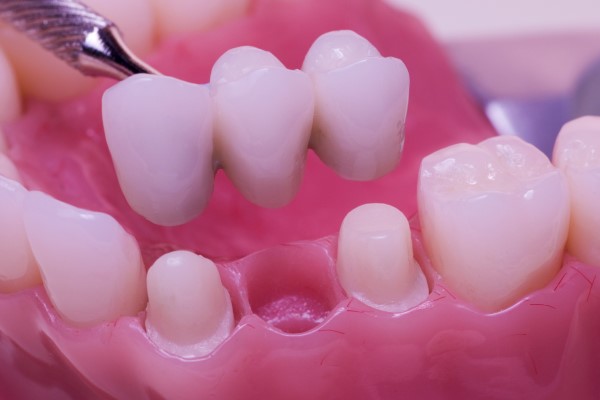How Many Teeth Can Dental Bridges Replace?

A missing permanent tooth should be replaced as soon as possible to prevent serious oral health issues. Dental bridges are one of the most commonly used treatments to replace a severely damaged or missing tooth. Many patients prefer this option because it is minimally invasive and requires only one or two trips to the dentist's office.
Understanding tooth replacement with dental bridges
When it comes to replacing a damaged or missing tooth, you have options. For many people, dental bridges are an effective way to restore a damaged smile. However, this treatment is not for everyone. It is important to understand what is required and what is involved before choosing dental bridges.
Treatment requirements
One of the most important factors to consider when choosing a treatment for tooth loss is the total number of missing or damaged teeth. While dental bridges are more commonly used to replace one tooth, they can actually be made to accommodate up to four adjacent missing teeth, depending on the patient. However, this requires that the surrounding teeth and tissues be healthy and strong enough to support the bridge. Patients who are missing more than four teeth in a row will need to consider another alternative for smile restoration, such as partial or complete dentures.
It is also important to note that dental bridges require more than just traditional brushing and flossing. Patients who are unable or unwilling to take extra steps to properly clean the area should discuss other options with a dentist. Otherwise, there is a much higher chance of developing tooth decay and gum disease.
Procedure steps
Before a dental bridge can be placed, all remnants of the missing or damaged teeth must be extracted. This will likely occur during a separate appointment. On the day of the treatment, the dentist will clean the area thoroughly and administer a local anesthetic to prevent any pain during the procedure. The adjacent healthy teeth are shaped and fitted for crowns, which will be used to anchor the bridge in place. In some situations, implants can also be used to anchor a dental bridge but will require additional preliminary dental work.
Once the mouth is fully prepped, scans or impressions are taken and sent to a lab where the crowns and bridge are milled to match the patient's unique tooth size, shape, and color. The production of the final product can take a few weeks, so a dentist will likely place a temporary bridge until the permanent one is ready. Then, the final bridge is mounted in place and the procedure is complete.
Follow-up care
Recovery from the dental bridge procedure is low-key and should involve managing only some mild inflammation and sensitivity for the first few days. Warm salt water rinses and cold compresses can help. The day after the procedure, patients should resume normal brushing and flossing, along with detailed cleaning of the bridge as instructed by a dentist. This will likely include the use of:
- Interdental brushes
- Floss threaders
- A water flosser
Food particles and bacteria can easily become trapped between the bridge and the gum line, so careful daily cleaning is essential. Patients should also avoid eating hard, tough, or sticky foods, as these can damage dental bridges.
The pros and cons of choosing dental bridges
All types of professional tooth restoration can help prevent unnecessary complications from missing teeth, including speech issues, digestive problems, oral pain, and improper tooth alignment. They can also help improve your confidence by eliminating the unsightly gaps that result from tooth loss. There are also some additional perks of specifically choosing a bridge to restore your smile.
For many people, they are a much more budget-friendly option than other treatments. They also offer results in just a few weeks, whereas other alternatives, such as implants, can take months or even a year to complete. Unlike dentures, dental bridges are securely mounted in place; they are not removed for cleaning and there is no need to worry about them slipping out of place when eating or talking.
While bridges are very effective for treating tooth loss, they will not last forever. With excellent home care and routine dental checkups, many patients can expect the appliance to last somewhere between 10 and 15 years before a replacement is needed. While the results tend to blend in very well with the surrounding teeth, they may not be as natural-looking as an implant upon close inspection.
Conclusion
Dental bridges are an excellent method for treating tooth loss in many people. They can replace up to four adjacent teeth with just one appliance. Talk with a dentist to determine if a bridge is right for you.
Request an appointment here: https://www.dentistryforwoodstock.com or call Dentistry for Woodstock at (770) 238-1437 for an appointment in our Woodstock office.
Check out what others are saying about our dental services on Yelp: Dental Bridges in Woodstock, GA.
Recent Posts
No one has to live with a gap in their smile due to missing teeth when a dental bridge offers a versatile and effective solution. It is also important to remember that replacing missing teeth is more than just a matter of cosmetics. Here is why bridging that gap teeth is important and how a…
Dental bridges are long-lasting tooth replacements. However, like anything, they sometimes need to be repaired or replaced. A general dentist can install, maintain, and repair bridges to help patients get the most out of these effective dental restorations.Before understanding dental bridge repair, it is important to understand how dental bridges work as a restorative treatment.…
Your dentist may recommend a dental bridge if your case needs it. Every patient has a different set of needs. Proper assessment allows the dentist to suggest the right dental replacement. Here are the details on when a dental bridge may become your dentist’s recommendation.Dentists often encourage their patients to stop consuming tobacco. Following this…
A dental bridge is a popular tooth replacement option for those missing one or several teeth. Missing teeth can cause problems that go beyond the aesthetic. Therefore, patients should replace teeth promptly to preserve the health and appearance of their smile. Fortunately, a dental bridge is an effective and natural-looking way to do that.A dental…


